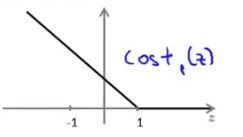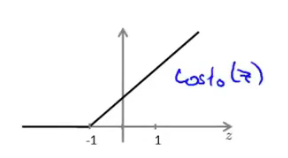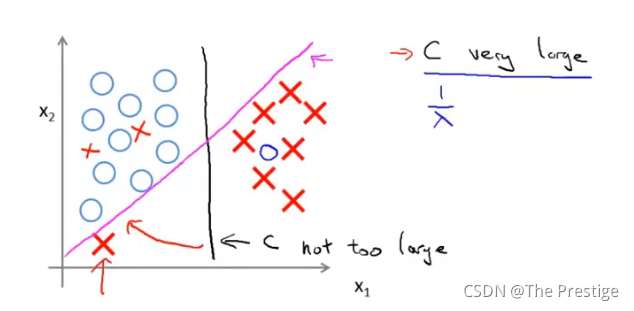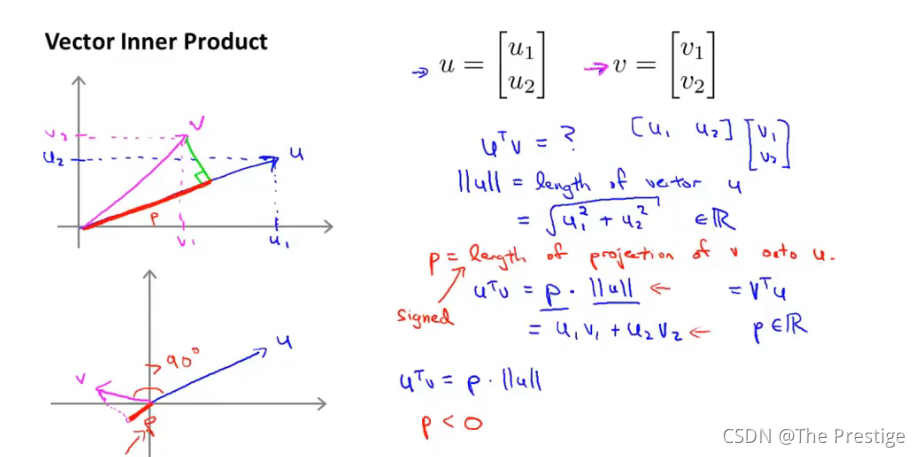12-1 Optimization objective
Alternative view of logistic regression
h θ ( x ) = 1 1 + e ? θ T x h _ { \theta } ( x ) = \frac { 1 } { 1 + e ^ { - \theta ^ { T } x } } hθ?(x)=1+e?θTx1?
If y = 1 y=1 y=1,we want h θ ( x ) ≈ 1 , θ T x ? 0 h_{\theta}(x)\approx1, \theta^Tx\gg0 hθ?(x)≈1,θTx?0
If y = 0 y=0 y=0,we want h θ ( x ) ≈ 0 , θ T x ? 0 h_{\theta}(x)\approx0, \theta^Tx\ll0 hθ?(x)≈0,θTx?0
? Cost of example: ? ( y log ? h θ ( x ) + ( 1 ? y ) log ? ( 1 ? h θ ( x ) ) ) - ( y \log h _ { \theta } ( x ) + ( 1 - y ) \log ( 1 - h _ { \theta } ( x ) ) ) ?(yloghθ?(x)+(1?y)log(1?hθ?(x))) = ? y log ? 1 1 + e ? θ r x ? ( 1 ? y ) log ? ( 1 ? 1 1 + e ? θ r x ) = - y \log \frac { 1 } { 1 + e ^ { - \theta ^ { r } x } } - ( 1 - y ) \log ( 1 - \frac { 1 } { 1 + e ^ { - \theta ^ { r } x } } ) =?ylog1+e?θrx1??(1?y)log(1?1+e?θrx1?)
Support vector machine
Logistic regression:
m
i
n
θ
1
m
[
∑
i
=
1
m
y
(
i
)
(
?
log
?
h
θ
(
x
(
i
)
)
+
(
1
?
y
(
i
)
)
(
?
log
?
(
1
?
h
θ
(
x
(
i
)
)
)
]
+
λ
2
m
∑
j
=
1
n
θ
j
2
min_\theta\frac { 1 } { m } [ \sum _ { i = 1 } ^ { m } y ^ { ( i ) }( -\log h _ { \theta } ( x ^ { ( i ) } ) + ( 1 - y ^ { ( i ) } ) (-\log ( 1 - h _ { \theta } ( x ^ { ( i ) } ) ) ] + \frac { \lambda } { 2 m } \sum _ { j = 1 } ^ { n } \theta^2_j
minθ?m1?[i=1∑m?y(i)(?loghθ?(x(i))+(1?y(i))(?log(1?hθ?(x(i)))]+2mλ?j=1∑n?θj2?
support vector machine:

m
i
n
θ
C
∑
i
=
1
m
[
y
(
i
)
c
o
s
t
1
(
θ
T
x
(
i
)
)
+
(
1
?
y
(
i
)
)
c
o
s
t
0
(
θ
T
x
(
i
)
)
]
+
1
2
∑
i
=
1
n
θ
j
2
min _ { \theta} C \sum _ { i = 1 } ^ { m }[ y ^ { ( i ) } {cost} _ { 1 } ( \theta ^ { T } x ^ { ( i ) } ) + ( 1 - y ^ { ( i ) } ) {cost} _ { 0 } ( \theta ^ { T } x ^ { ( i ) } ) ] + \frac { 1 } { 2 } \sum _ { i = 1 } ^ { n}\theta_j^2
minθ?Ci=1∑m?[y(i)cost1?(θTx(i))+(1?y(i))cost0?(θTx(i))]+21?i=1∑n?θj2?
SVM hypothesis
m
i
n
θ
C
∑
i
=
1
m
[
y
(
i
)
c
o
s
t
1
(
θ
T
x
(
i
)
)
+
(
1
?
y
(
i
)
)
c
o
s
t
0
(
θ
T
x
(
i
)
)
]
+
1
2
∑
i
=
1
n
θ
j
2
min _ { \theta} C \sum _ { i = 1 } ^ { m }[ y ^ { ( i ) } {cost} _ { 1 } ( \theta ^ { T } x ^ { ( i ) } ) + ( 1 - y ^ { ( i ) } ) {cost} _ { 0 } ( \theta ^ { T } x ^ { ( i ) } ) ] + \frac { 1 } { 2 } \sum _ { i = 1 } ^ { n}\theta_j^2
minθ?Ci=1∑m?[y(i)cost1?(θTx(i))+(1?y(i))cost0?(θTx(i))]+21?i=1∑n?θj2?
Hypothesis:
h θ ( x ) = { 1 i f ?? θ T x ≥ 0 0 o t h e r w i s e h_\theta(x)=\begin{cases}1\quad if\;\theta^Tx\ge0\\0\quad otherwise\end{cases} hθ?(x)={1ifθTx≥00otherwise?
12-2 Large Margin Intuition
Support Vector Machine
if y = 1 y=1 y=1,we want $\theta^Tx\ge1\quad(\text{not just ≥ \ge ≥ 0})$

if
y
=
0
y=0
y=0,we want $\theta^Tx\le-1\quad(\text{not just
<
<
< 0})$

SVM Decision Boundary
SVM Decision Boundary: Linearly separable case

Large margin classifier in presence of outliers

12-3 The mathematics behind large margin classification (optional)
Vector Inner Product 向量内积

SVM Decision Boundary


12-4 Kernels I
核函数
Non-linear Decision Boundary
predict y=1 if θ 0 + θ 1 x 1 + θ 2 x 2 + θ 3 x 1 x 2 + θ 4 x 1 2 + θ 5 x 2 2 + ? ≥ 0 { \theta _ { 0 } + \theta _ { 1 } x _ { 1 } + \theta _ { 2 } x _ { 2 } + \theta _ { 3 } x _ { 1 } x _ { 2 } } { + \theta _ { 4 } x _ { 1 } ^ { 2 } + \theta _ { 5 } x _ { 2 } ^ { 2 } + \cdots \geq 0 } θ0?+θ1?x1?+θ2?x2?+θ3?x1?x2?+θ4?x12?+θ5?x22?+?≥0
h θ ( x ) = { 1 i f ?? θ 0 + θ 1 x 1 + θ 2 x 2 + θ 3 x 1 x 2 + ? ≥ 0 0 o t h e r w i s e h_\theta(x)=\begin{cases}1\quad if\;{ \theta _ { 0 } + \theta _ { 1 } x _ { 1 } + \theta _ { 2 } x _ { 2 } + \theta _ { 3 } x _ { 1 } x _ { 2 } } { + \cdots \geq 0 }\\0\quad otherwise\end{cases} hθ?(x)={1ifθ0?+θ1?x1?+θ2?x2?+θ3?x1?x2?+?≥00otherwise?
Given x,compute new feature depending on proximity to landmarks l ( 1 ) , l ( 2 ) , l ( 3 ) l^{(1)},l^{(2)},l^{(3)} l(1),l(2),l(3)
Kernels and Similarity
f 1 = s i m i l a r i t y ( x , l ( 1 ) ) = e x p ( ? ∣ ∣ x ? l ( 1 ) ∣ ∣ 2 2 σ 2 ) = exp ? ( ? ∑ j = 1 n ( x j ? l j ( 1 ) ) 2 2 σ 2 ) f_1=similarity(x,l^{(1)})=exp(-\frac{||x-l^{(1)}||^2}{2\sigma^2})=\operatorname { exp } ( - \frac { \sum _ { j = 1 } ^ { n } ( x _ { j } - l _j^{ ( 1 ) } ) ^ { 2 } } { 2 \sigma ^ { 2 } } ) f1?=similarity(x,l(1))=exp(?2σ2∣∣x?l(1)∣∣2?)=exp(?2σ2∑j=1n?(xj??lj(1)?)2?)
I f ?? x ≈ l ( 1 ) : If \; x\approx l^{(1)}: Ifx≈l(1): f 1 ≈ 1 f_1\approx 1 f1?≈1
I f ?? x ?? i f ?? f a r ?? f r o m ?? l ( 1 ) : If \;x\; if \; far \; from\;l^{(1)}: Ifxiffarfroml(1): f 1 ≈ 0 f_1\approx 0 f1?≈0

12-5 Kernels II
Choosing the landmarks
SVM with Kernels
Given ( x ( 1 ) , y ( 1 ) ) , ( x ( 2 ) , y ( 2 ) ) , ? ? , ( x ( m ) , y ( m ) ) ( x ^ { ( 1 ) } , y ^ { ( 1 ) } ) , ( x ^ { ( 2 ) } , y ^ { ( 2 ) } ) , \cdots , ( x ^ { ( m ) } , y ^ { ( m ) } ) (x(1),y(1)),(x(2),y(2)),?,(x(m),y(m))
choose l ( 1 ) = x ( 1 ) , l ( 2 ) = x ( 2 ) , ? ? , l ( m ) = x ( m ) l ^ { ( 1 ) } = x ^ { ( 1 ) } , l ^ { ( 2 ) } = x ^ { ( 2 ) } , \cdots , l ^ { ( m ) } = x ^ { ( m ) } l(1)=x(1),l(2)=x(2),?,l(m)=x(m)
Given example x:
? f 1 = s i m i l a r i t y ( x , l ( 1 ) ) f 2 = s i m i l a r i t y ( x , l ( 2 ) ) ? \begin{array}{l}f_1=similarity(x,l^{(1)})\\f_2=similarity(x,l^{(2)})\\\cdots\end{array} f1?=similarity(x,l(1))f2?=similarity(x,l(2))??
For training example ( x ( i ) , y ( i ) ) ? f ( i ) (x^{(i)},y^{(i)})\longrightarrow f^{(i)} (x(i),y(i))?f(i)
Hypothesis: Given x,compute features f ∈ R m + 1 f\in \mathbb{R}^{m+1} f∈Rm+1
Predict “y=1” if θ T f ≥ 0 \theta^T f\ge 0 θTf≥0
Training: m i n θ C ∑ i = 1 m [ y ( i ) c o s t 1 ( θ T f ( i ) ) + ( 1 ? y ( i ) ) c o s t 0 ( θ T f ( i ) ) ] + 1 2 ∑ i = 1 n θ j 2 min _ { \theta} C \sum _ { i = 1 } ^ { m }[ y ^ { ( i ) } {cost} _ { 1 } ( \theta ^ { T } f ^ { ( i ) } ) + ( 1 - y ^ { ( i ) } ) {cost} _ { 0 } ( \theta ^ { T } f ^ { ( i ) } ) ] + \frac { 1 } { 2 } \sum _ { i = 1 } ^ { n}\theta_j^2 minθ?C∑i=1m?[y(i)cost1?(θTf(i))+(1?y(i))cost0?(θTf(i))]+21?∑i=1n?θj2?
SVM parameters:
C ( = 1 λ ) C(=\frac{1}{\lambda}) C(=λ1?).
Large C: Lower bias, high variance.(small
λ
\lambda
λ)
Small C: Higher bias, low variance.(
l
a
r
g
e
??
λ
large\;\lambda
largeλ)
σ 2 \sigma^2 σ2
Large σ 2 \sigma^2 σ2: Features f i f_i fi?; vary more smoothly. Higher bias, lower variance.
Small σ 2 \sigma^2 σ2: Features f i f_i fi?; vary less smoothly. Lower bias, Higher variance.
12-6 Using an SVM
Use SVM software package (e.g. liblinear, libsvm, …) to solve for parameters θ \theta θ
Need to specify:
Choice of parameter C
Choice of kernel (similarity function):
? E.g. No kernel (“linear kernel”)
θ 0 + θ 1 x 1 + θ 2 x 2 + θ 3 + ? ≥ 0 ? n ?? l a r g e , m ?? s m a l l \theta _ { 0 } + \theta _ { 1 } x _ { 1 } + \theta _ { 2 } x _ { 2 } + \theta _ { 3 } + \cdots \ge 0 \longrightarrow n\;large,m\;small θ0?+θ1?x1?+θ2?x2?+θ3?+?≥0?nlarge,msmall
? predict:“y=1” if θ T x ≥ 0 \theta^Tx\ge0 θTx≥0
? Gaussian kernel:
f i = e x p ( ? ∣ ∣ x ? l ( i ) ∣ ∣ 2 2 σ 2 ) , w h e r e ?? l ( i ) = x ( i ) f_i=exp(-\frac{||x-l^{(i)}||^2}{2\sigma^2}),where\;l^{(i)}=x^{(i)} fi?=exp(?2σ2∣∣x?l(i)∣∣2?),wherel(i)=x(i)
? Need to choose σ 2 \sigma^2 σ2
Kernel (similarity) functions:
function f= kernel(x1,x2)
f=exp((-abs(x1-x2)^2)/(2*(sigma^2)))
return
Note: Do perform feature scaling before using the Gaussian kernel
=[](#4-3 Gradient descent in practice I: Feature Scaling)
Other choices of kernel
Note: Not all similarity functions similarity(x, l) make valid kernels (Need to satisfy technical condition called"mercer’s Theorem"to make sure SVM packages’ optimizations run correctly, and do not diverge)
Many of-the-shelf kernels avaliable:
- Polynomial kernel: k ( x , l ) = ( x T l ) 2 , ( x T l + 1 ) 3 , ( x T l + 5 ) 4 k(x,l)=(x^Tl)^2,(x^Tl+1)^3,(x^Tl+5)^4 k(x,l)=(xTl)2,(xTl+1)3,(xTl+5)4
- More esoteric: String kernel, chi-square kernel, histogram intersection kernel
Multi-class classification

Logistic regression vs. SVMS
m=number of features(
x
∈
R
n
+
1
x\in \mathbb{R}^{n+1}
x∈Rn+1), m =number of training examples
If n is large(relative to m)
Use logistic regression, or SVM without a kernel (“linear kernel”)
If n is small, m is intermediate:
Use SVM with Gaussian kernel
If m is small, m is large:
Create/add more features, then use logistic regression or SVM without a kernel
Neural network likely to work well for most of these settings, but may be slower to train